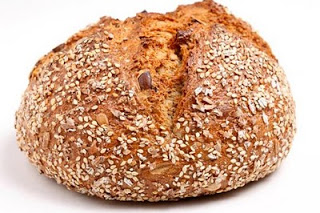Wicked! Are Bread Sins Going Unpunished?

Even the most ardent healthy eating enthusiast will agree that there’s more to a well-rounded diet than fruits and veggies.
There is also Grain.
Grain is simply a staple no matter where in the world you live. Italians consume loads of pasta, Asians devour tons of rice – even the ancient grain of the Incas, quinoa, has had a resurgence. Grains aren’t just the foundation of a good diet – in their minimally processed form, they have huge health benefits.
Current dietary guidelines recommend eating 6 to 11 servings of grain products daily, including at least three whole-grain foods. (Find the recommended amount of grains for your age and gender.) While the Department of Health and Human Services called for 75% of Americans to meet whole grain intake goals by this year, only 7% reportedly do. While grains are consumed heartily, for most of us, they are not whole grains.
Breadly Sins
Grains have earned their good food classification, but when it comes to processing, they take a devilish turn. It’s not that processing is all bad. Some minimally processed grains can get the thumbs up, like brown rice, barley, and oats, for example. That being said, substituting whole grains for refined grains can help lower risk for diabetes, stroke, heart disease and some cancers. If you’ve taken up brown rice over white and darker breads for white squishy ones, you’re on the right track – you are preserving the vitamin and mineral-rich “germ” of the wheat that gets stripped out in the refining process.
Deceptive Foods
Divine Caroline helped pull back the curtain on deceptive foods in a recent post about supermarket breads. Deceptive foods are those with healthy-sounding names (termed “healthful halos”) that hide the fact they should be on the Don’t list. She outs breads that hide towering sodium amounts, bleached flour and high fructose corn syrup, despite their deceptively healthy names. (Does Healthy Choice 7-Grain Bread sound nutritious? Better check the label.)
It’s a good idea to get bread savvy: when it comes to grains, marketing jargon can obfuscate food evils. Common misnomers include stone ground, organic and 7-grain. While these terms sound healthful, they don’t designate a whole grain product, and they may hide a multitude of diet and nutrition sins to boot.
Another common bread blunder is seeking out brown breads as a way of separating “good” from “bad”. Avoiding white by choosing tan colored breads is well-intentioned, but a toasty color doesn’t always mean whole wheat. Breads can be colored by caramel and molasses, turning evil white to a seemingly angelic brown without the advantages.
Addressing the Grains (Hello, Grains)
Any food made from wheat, rice, oats, cornmeal, barley or another cereal grain is a grain product. Bread, pasta, oatmeal, breakfast cereals, tortillas, and grits are some common examples. (MyPyramid.gov provides a reference list of what foods fall into the grain group.) When we refer to grains, we are generally referring to these subgroups:
1. Whole Grains
Whole grains contain the entire grain kernel — the bran, germ, and endosperm. Examples include whole wheat flour, bulgar and oatmeal. Often, cereals can be labeled “whole grain” because they include the entire corn kernel in its ingredients, even though the cereal also contains corn syrup and artificial dyes.
Whole grain foods also contain higher amounts of fiber, and some contain significant amounts of bran. But research suggests that it’s the whole-grain that delivers abundant amounts of antioxidant vitamins and phytochemicals that appear to act together to provide protective effects.
Refined grains have been milled, a process that removes the bran and germ. This is done to give grains a finer texture and improve their shelf life, but it also removes dietary fiber, iron, and many B vitamins. By removing the germ and bran from the grain, whole grains are turned into refined carbs stripped of nutrients. Some examples of refined grains are white flour, white bread and white rice. Most pitas, tortillas, and crackers are made with refined grains, though some are not, and some may be a mixture of both refined and whole.
3. Enriched & Fortified Grains
Many refined grain products have key nutrients, such as folic acid and iron, that were removed during the initial processing and added back, earning them the name enriched. White rice and white bread are enriched grain products, and their packaging indicates as much. This means certain B vitamins (thiamin, riboflavin, niacin, folic acid) and iron are added back after processing. (Fiber is not added back to enriched grains.) In addition, some enriched grain foods have extra nutrients added. These are called fortified grains, a term you’ll recognize from many cereal packages.
4. Multigrains
We often hear the term multigrain when we shop for breads. It sounds healthful enough that we tend to associate it with whole grain. In fact, multigrain means what it says: different types of grains have been included, and none of them have to be whole grain. Multigrain breads are as likely as any bread to have enriched flour as their first ingredient.
Shopping for Virtuous Grains: The Bottom Line
Are you gazing affectionately at a virtuous bread product or are you staring evil in the face? No guesswork is required to figure this out: Simply check the ingredient list.

- If “whole” doesn’t appear in the first ingredient you see, it’s not a whole grain product, and you may be treading in the land of bad bread.
- Don’t trust the marketing. Any whole or multigrain brand name could still contain refined grains, so pay attention to ingredients.
- High fructose corn syrup at the top of the list? Hydrogenated oil making an appearance? You’re in black hat territory, no matter what the angelic name on the package is.
- Finally, check the fiber content. If the Nutrition Facts has less than 2-4 grams of fiber content per serving, say buh-bye, bread.


